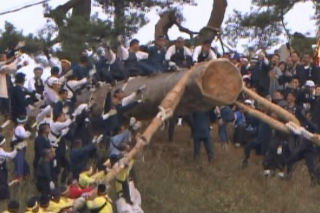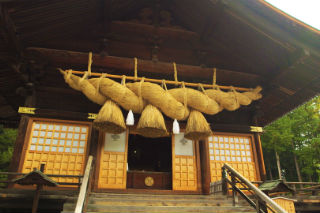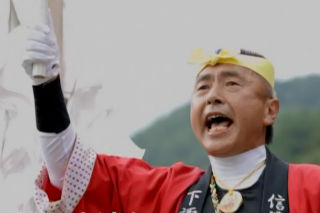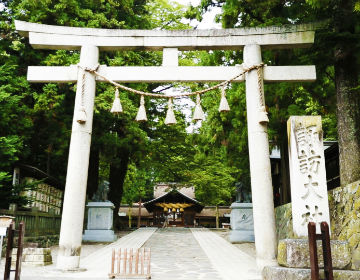Festival only once in 7 years “Onbashira Sai”
Onbashira Sai (festival) is the biggest Shinto ritual in the Suwa area. It is a series of events held once in seven years, where giant wood weighing about 20 tons each is pulled from the mountain to the village, then set upright on the premises of Suwa Taisha. People who sing during the festival are called Kiyari artisans. Naoto Komatsu, chairman of Shimo Suwa Kiyari Preservation Association, greeted us at Suwa Taisha. Onbashira is a sign that god has descended, and plays the role of a barrier. ”The tradition of cutting Onbashira wood from the mountains in the year of the monkey and tiger has continued from over 1200 years ago. The ritual is a phase of life for local people”, Komatsu explained. People set up their own goals up to the next Onbashira Sai, like ”I’ll try to stay healthy ”and ”I’ll try to train young artisans”.

Kiyari unites the hearts of people
We were guided to the starting point of Onbashira called ”Tanakiba”. From there, you can see the national forest where big fir trees which later become Onbashira grow. Onbashira wood, about 150 to 200 years old, are cut down a year prior to the festival, and are laid there. As you proceed from ”Tanakiba” you will come across a slope where the wood is slid down. This is where the highlight of the festival, ”Kiotoshi” (tree dropping) takes place. The sight of giant trees sliding down the slope carrying parishioners is overwhelming. ”The slope has an angle of 35 degrees and is 100 meters long” Komatsu explained. At the beginning of the hill, there is an Onbashira for tourists. Before ”kiotoshi”, kiyari song asking for people’s cooperation is sung. Kiyari song is a sign that Onbashira pulling will start, to unite the hearts of parishioners. By singing in high-pitched voices loud enough to reach heaven, they unite their hearts. We were honored with the opportunity to hear the kiyari song, and Nakata took part in it by participating calling out.

Song of Kiyari passed down from one generation the next
We then headed for Suwa Taisha Shimosha Harumiya, where Onbashira is enshrined. Here we met a master of Kiyari, Takaharu Hayashi, who also happens to be a senior of Komatsu. He sang us the Kiyari which is sung when returning the god after the Onbashira arrives. This was the place where Komatsu received training from Hayashi. ”I have considered quitting, but thanks to my master, I am who I am now”, Komatsu reflected. Kiyari is another tradition that has been handed down from generation to generation. Hayashi told us, ”I inherited the passion of preserving this tradition from my senior Kiyari masters. Because younger Kiyari singers tried hard to overcome the difficulties of continuing the tradition, Kiyari songs are still sung today.”




